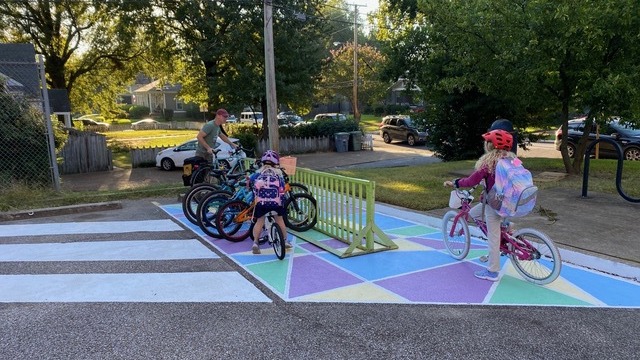Memphis has several neighborhood schools with families living within a mile or two of the building. For these families, bicycling to school can be a safe and fun option, thanks to low-stress neighborhood streets and crossing guards at the large intersections closest to the school.
However, what do you do with the kids’ bikes once you arrive at school? Some schools have sturdy bike racks available. But our very informal survey of Midtown and North Memphis schools shows that many schools lack a secure place to store bikes for the day.
Never fear! Commute Options has a solution. In just one weekend, you and your fellow parents can create a space to help your school community pedal to school. Last fall, our friends at Idlewild Elementary were experiencing a problem that we like — so many families were cycling to school that the bike rack was at maximum capacity. The school owned a second rack, but it was behind the school and co-mingled with a carpool line.
An engineering dad had the idea to move the extra bike rack up front near the maxed-out rack. After a consultation with the principal, we determined that we could simultaneously solve another issue for the school. The handicap car parking space did not have the required buffer zone allowing easy access from either side of a car. The principal gave us permission to take over two car parking spaces for our bike rack, and to use a third space to paint the needed buffer zone for the handicap space. Now, Idlewild Elementary offers a highly visible spot for more families to bike to school, and guests using the handicap parking space have the required room necessary for ADA-access.
In order to create something beautiful as well as functional, we researched how to paint the bicycle rack space and consulted with local artist Anthony Lee from the Marshall Arts gallery in the Edge District. We learned several important things:
- The painted surface will stain and dull over time. The solution: priming the parking space with PPG (Brand) Gripper Primer, tinted to a light-to-medium grey. As the topcoat wears, it will reveal the undercoat; white-colored “chipping” is more visually disruptive than grey-colored chipping.
- Overfilling this surface may lead to a slicker surface on wet days. The solution: sprinkling sand evenly and lightly on top of wet primer coat.
- The topcoat needs to be any exterior-grade acrylic latex, in a satin finish. Color selections should offer some complexity because primary and secondary colors are the frailest against UV light and weathering.
- It is very important to measure! Bikes take up more space on the rack than you might think.
- Be sure to install the rack properly so bicycle riders can take full advantage of all of the parking capacity.
To prepare the space, Lee advised us to use wide regular masking tape to mask the curb and make clean lines and to sweep before priming. As he anticipated, our space had a spot saturated with motor oil. To remediate that area, we first scrubbed it with dish soap, then sprinkled it with kitty litter, that we then swept up.
The site preparation was done in one day. On day two (a Friday), we swept, marked the space, and primed with paint and sand to create a “grippy” surface. On Saturday, local artist and school dad, Gino Barzizza, tapped a design, and we painted it with two coats of color. On Sunday, Principal Kiersten Schnacke and some Idlewild dads moved the bike rack to its new spot. Finally, we all rolled up to test it out. It worked great!
We benefited from having an extra bicycle rack on another part of the property. But sturdy and secure racks are not very expensive. And Commute Options is happy to advise when your school is ready to purchase a new one. New bike racks can also be customized in colors and with the name and logo of your school, if you really want to get fancy.
To get a look at how we created the Idlewild bike rack, you can watch this great video, created by a parent.
Sylvia Crum joined Innovate Memphis in 2019 as the Commute Options Program Manager. This work allows her to encourage local businesses, employees, and students to shift from drive-alone commutes to transit, walking, carpooling, and bicycling.

